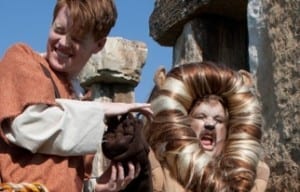OREM — It would probably be impossible to create a better opening scene of SCERA’s production of The Sound of Music. As Chelsea Hendrickson sang the opening notes of the title song with Mount Timpanogos behind her, it quickly became clear that director Jeremy Showgren and the production artists had the ingredients for a wonderful evening of theatre.
The Sound of Music, of course, is the Rodgers and Hammerstein musical about Maria, a postulant at a nunnery who is asked to serve as a governess for the seven von Trapp children. As Maria teaches the children to sing and play, the von Trapps become a real family. But as I have stated on UTBA before, the story is much deeper than most people give it credit for, as Howard Lindsay and Russel Crouse‘s script also explores questions of freedom and standing up for one’s beliefs. Showgren effectively balanced the adult lessons of the script with the upbeat wholesome mood that audience members expect from a Rodgers and Hammerstein musical.
Hendrickson as Maria embodied the joy that music brings to the soul as she sang “Favorite Things,” “The Sound of Music,” and “Do Re Mi.” In addition to her wholehearted acting performance in these songs, Hendrickson sounded gorgeous as her professional-quality voice rang out in the SCERA amphitheater in “Confidence” and “Something Good.” Indeed, there was not a sour note in any of her songs. Moreover, Hendrickson had a great rapport with the child actors in the cast, and it was easy to see why Maria would endear herself to the the von Trapp children. Opposite Hendrickson was Mark Buffington as Captain von Trapp, a role that is much more difficult than many audience members may realize. Buffington was careful to find a balance between the military bearing of the character and the softness that the Captain must show as the play progresses. Buffington was strongest in his faceoff with the Nazi characters and when interacting with Phil Varney (as Max Detweiler) and Rebekah Osmond (Elsa Schraeder). Buffington was not as strong of a vocalist as Hendrickson, but his sweet singing in the first reprise of “The Sound of Music” and “Something Good” suited the character well and highlighted the emotional content of the score.
Among the von Trapp children the most entertaining were Jessica Sundwall (as Liesl), Isabella Hixson (as Brigitta), and Sophie Osmond (as Gretl). Sundwall’s “Sixteen Going on Seventeen” with Corey Morris (as Rolf Gruber) was delightful as Sundwall was a giddy teenager in the throws of her first love. Hixson’s acting in the ballroom scene was effective in showing the audience how Captain von Trapp and Maria’s feelings were growing, mostly because Hixson’s delivery of her lines sounded nothing like the wooden recitations often heard in school plays for children her age. Finally, Sophie Osmond had the cute factor that made me say, “Ahhhh,” more than once.
It’s also important to discuss Rebekah Osmond and Varney’s performances. The characters of Elsa and Max are often underappreciated, perhaps because the two roles are much smaller in the 1965 film than in the stage version. The two actors’ performance in “No Way to Stop It” distilled their characters’ relationships with Captain von Trapp as the two performers enthusiastically sang the cynical lyrics. By the end of the song it was clear why the captain couldn’t marry Elsa and why he disliked Max viscerally. Individually, Rebekah Osmond’s high class decadence was perfect for Elsa; it subtly showed from her first scene that what Elsa and the captain valued were quite different. Varney, on the other hand, was the closest resemblance of comic relief in The Sound of Music. Without going inappropriately over the top, Varney showed Max as a sleazy moocher who was willing to flatter whomever would give him a free meal and drink. Most other supporting cast members had respectful performances, although the female cast and ensemble members were generally better their male counterparts.
Beneath Showgren’s direction was an exquisite team of designers who helped create the Austrian setting of The Sound of Music. Nat Reed‘s set was functional and beautifully painted. More importantly, the set permitted scene transitions to happen quickly, which greatly contributed to the brisk pacing of the production. Reed’s set also helped establish the sinister mood of the concert hall scene (which was reinforced by the numerous Nazis pacing the aisles of the audience seating). The best visual element of the production, though, was Deborah Bowman‘s costume designs. All of Bowman’s designs helped create characters and communicate information to the audience. For example, the first costume that Buffington wore showed how formal and authoritarian the character was. Likewise, the dresses worn by Hendrickson and Rebekah Osmond were different in ways that highlighted the characters’ differing social standings and goals. In general, though, Bowman’s costumes were suitable for the performers, and (like any good design) never detracted from the story, even when they were historically inaccurate (such as for the Nazis).
Finally, it would be inappropriate to close a review of The Sound of Music without discussing the music direction, which was also done by Showgren. In nearly every song Showgren and the cast consciously eschewed any imitation of the vocal choices made by the film’s cast. This decision made the SCERA production of The Sound of Music a unique work of art and not just another community theatre production of an old musical workhorse. “Confidence,” “How Do You Solve a Problem Like Maria?” and “Do Re Mi” were all peppered with unique musical phrases that will almost certainly provide some pleasant surprises for any longtime fan of The Sound of Music. However, some of the prerecorded music sounded artificial and tinny, and the harmonies in the first reprise of the title song were out of tune. But these are minor qualms that most audience members will easily overlook (perhaps because there were no microphone problems during the entire evening).
SCERA’s production of The Sound of Music is a noteworthy accomplishment; it’s a pleasure to watch the cast and crew fulfill the potential of the classic script and score. But the most important aspect of this production is that it has heart. As Captain von Trapp forcefully explains, “I will not bow my head to these men I despise,” the important lessons of The Sound of Music should be clear to audience members of almost any age. The fact that this message is accompanied by some fine amateur performances, elegant costumes, and dazzling vocals makes this show a valued contribution to the Utah theatre calendar this summer.








